Usability testing tools are growing in numbers and features. But which is the right one for you? Take a look at this list of 15 awesome platforms and find out!
Usability is a key concern in all digital products now. It is true that users of all backgrounds are no longer willing to suffer bad usability for any end. Today, terrible usability means a short lived product.
Design, Prototype and Test the usability of your web and mobile apps with Justinmind. For Free. Unlimited projects!

That is when usability testing tools come into the picture. Depending on what your product is, the size of your team and what you’re trying to accomplish, you’ll choose one tool or the other. But while each of these usability testing tools have their own unique side, they all serve a common purpose: they are here to help you speak the same language as your users.
And so, let’s take a closer look at each of these usability testing tools – and see just what makes them so special, as well as what current users had to say about them.
Usability is a delicate thing. Designers have to find creative ways to combine what they think is best with the user’s perception of what is best. That touches on everything in the product: from visuals like the color scheme, to the navigation and interactions. But how can you understand what another individual prefers? Well – you gotta ask them.
The idea is that you get a representative group of users and see what is best in their opinion. Granted, simply “asking” may be simplifying it. It does involve a whole process of research and planning before you even get to the actual testing.
If you want the full run-through of the planning and process, do check out our post on how to do usability testing. In the meantime, here are the basics.
A usability test is the act of putting a prototype of your product in front of a user and carrying out an interview. This usually goes with a set of activities or tasks that participants are asked to do with the prototype.
To get an idea: Go ahead and check out the 8 must-ask user testing questions to get a feel of what you should be asking participants.
The important idea here is that the person conducting the test needs to observe and listen to users with close attention – this isn’t a time to explain how anything works. Users need to meet a product that they aren’t familiar with at all: this is how you understand the learning curve involved in using your product.
Here at Justinmind, we firmly believe in making data-driven decisions – that’s what usability testing is all about. You want to test your product on as many users as possible, and establish certain standards to compare the results to.
It’s important to establish these criteria, because they will give you direction. Where do you draw the line? How do you know the design needs to improve, or that it’s gotten to where it needs to be?
While all of this may sound like a complex process, the idea behind it all remains simple. You want to:
- Find out if your product passes on certain usability standards
- Identify areas where the design could be improved
- Understand if the product truly solves a problem for users
- Improve on the design repeatedly using the test results as guidance
Generally, we have a few types of usability tests – any of which could be a good fit for your project. These will also dictate which one among usability testing tools would be a better fit for you. Check out what differentiates each of them:
- In-person: face-to-face between interviewer and user. This is ideal, but can be out of reach if budget is tight or if participants are tough to find.
- Remote: done through a computer, with the participant and the interviewer in different locations.
- Moderated: a remote user test, with the interviewer overseeing the test. The interviewer may ask questions and interact with the participant (although it can be tough to do this in a natural way while the test takes place).
- Unmoderated: participants do the test on their own, with pre-established tasks and steps. These sessions tend to be recorded for further observation.
For research purposes, we took a look at each of the platforms’ features as well as reviews left by customers on G2. Also, keep an eye out – many of these usability testing tools have integrations with Justinmind. You can read all about Justinmind’s integration with user testing tools for more information.
It’s important to bear in mind that all of these usability testing tools are aimed at remote tests – which may be moderated or unmoderated.
UserZoom is a huge name in the usability testing tools market. It’s no surprise, really. Reaching the top of the game seems like a natural thing for a tool that offers 537% return on investment. Yes, there is an actual study carried out by Forrester Research with UserZoom that found some incredible statistics.
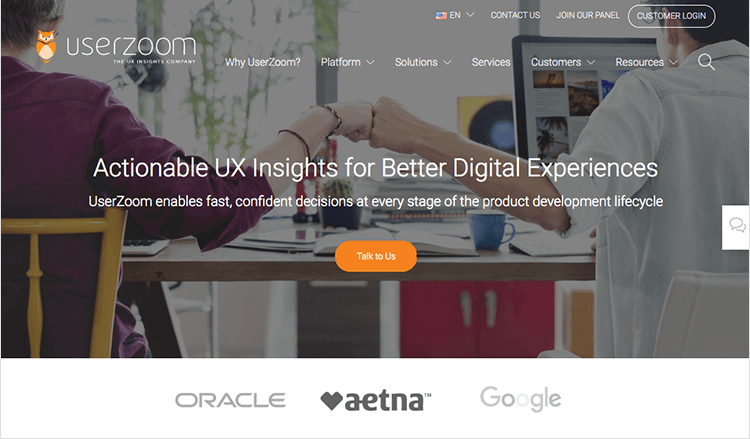
But when it comes to features and functionality: UserZoom offers the option to use your own participants in studies or making use of their advanced search engine – which has about 120 million possible participants. Reviews left by users of the platform praise it for the quick feedback and ability to carry out several studies in fast succession.
A cool aspect of this platform is that you can customize the plan so it includes only the add-ons you need for your project or company – such as the audience search engine.
Also: UserZoom has an integration with Justinmind's prototyping tool!
Design, Prototype and Test the usability of your web and mobile apps with Justinmind. For Free. Unlimited projects!

- Who is it for: startups and small/medium businesses
- Price: available upon request
UserTesting is another big player in the usability testing game. The platform has some great features such as its Live Conversations that allow for real back-and-forth with participants.
A majority of users seem to agree that UserTesting’s Highlight Reel feature is one of its strongest points.
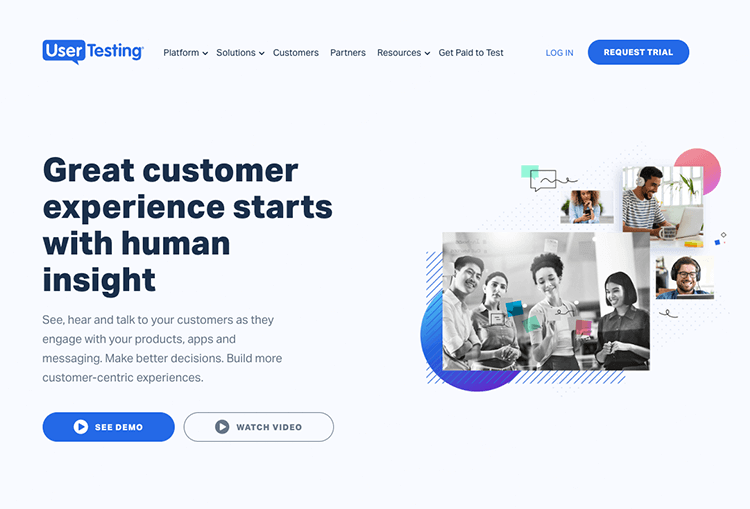
By offering video recordings of key moments during the test (of confused or lost users), researchers have very compelling arguments to make to skeptical stakeholders. After all, getting everyone on board with making more changes to the design tends to be a challenge, especially in big companies.
By the way: UserTesting is integrated with Justinmind. That way, your prototypes can get validated early, as often as you like. Usability testing - made easy!
Users praise the platform’s customer service for their quick replies and helpful input whenever it is needed. Plans come in either Individual (up to 15 video sessions) or Enterprise (on demand, customizable).
- Who is it for: enterprises, small and medium businesses
- Price: available upon request
Validately is one of the simpler contenders when it comes to usability testing tools. It focuses on handling all the details while the organizers of the study can focus on the tasks and questions.
The platform gives its users the ability to sit back and simply establish the criteria for who can take the test, letting Validately mind the rest. It recruits, sets up, and carries out the test without any hiccups. For users who want to be more involved, Validately goes as far as you need it to.
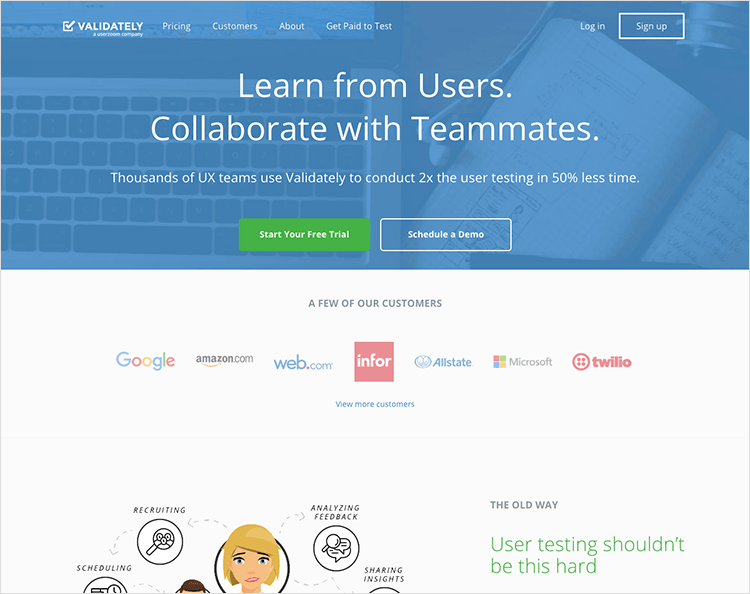
It is true that among user reviews, there are a few ups and downs. Users praise their online video chats for their practicality, as well as the fact that participants don’t need to download any plugins or apps.
By the way: Validately is also integrated with Justinmind for extra quick usability testing of prototypes and wireframes!
Among the downs are some reviews that point out that while Validately is wonderful at gathering data, it falls short of organizing the data into clear insights. For users who struggle with brute statistics and numbers, this tool might represent a steep learning curve.
- Who is it for: small and medium sized businesses
- Price: starts at 499$/month for most basic plan, jumps to 1248$/month for Collaborate plan. Enterprise plan price available upon request.
Loop11 is among the usability testing tools that focuses on unmoderated remote tests, expanding to any type of device. It includes a whole set of tools such as A/B testing, testing of live websites or prototypes as well as heat maps and clickstream analysis.
With Loop11, users need to bring their own participants – but the wide gap in cost between this tool and other usability testing tools on this list might make up for that fact. While Loop11 doesn’t have a participant database, users are welcome to bring in an unlimited amount of users (with the Pro plan).

It is true that in order to participate, people will have to download the Loop11 app on their personal devices. This can make it more challenging to find willing participants, as people can feel negatively towards the idea of adding things to their devices.
- Who is it for: small and medium businesses
- Price: Rapid Insights plan at 69$/month, Pro plan at 249$/month
UsabilityHub is one of the usability testing tools on this list that aims for simplicity.
One of their features, for example, is simplicity in itself: participants are shown a page for 5 seconds. Afterwards, they are asked what they remember about the page – all answers are listed. In the end, users have a word cloud with the things participants found most memorable. This helps designers adjust the design to make a lasting impression.

Among the features of UsabilityHub that we love is their advanced heat maps, that go beyond simply marking of click-density. This platform actually gives information and data along with the heat map, such as time-to-click.
Like other usability testing tools, it gives users the option to draw from the participant database or recruit their own participants. For users who bring in their own participants, there is no limit of how many people can take part in the study. If you prefer to rely on their participant database, you’ll be able to list out specific demographics that interest you.
- Who is it for: startups, small and medium businesses
- Pricing: plans vary from 79$/month to 396$/month
Crazy Egg is a well established name in the midst of usability testing tools. The great thing about this platform is that it offers a variety of reports that place the data in a different light each time. Depending on what it is you want to know about the design, you may choose one or the other.
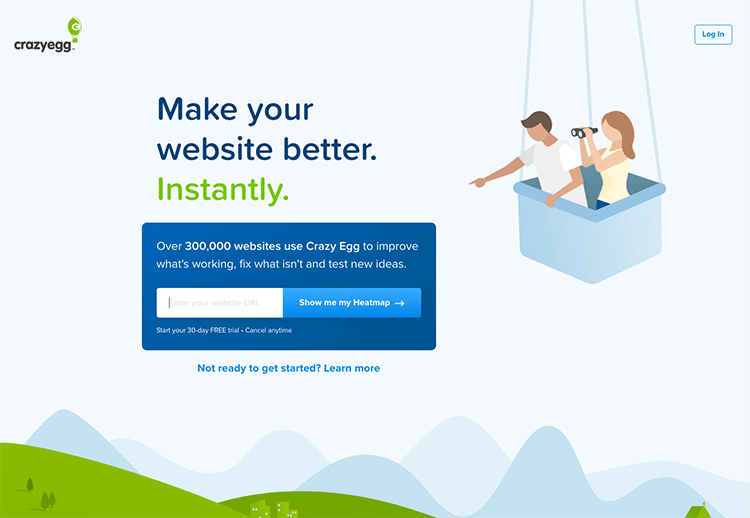
Crazy Egg is, perhaps, most known for their heat maps. And while that is a good feature, we love other aspects of this user testing tool as well. Users praise their Scroll Map feature, which is perfect for knowing at which point in the page you lose participants’ interest. This is quite handy when deciding where the call-to-action should be!
Don’t miss out: Crazy Egg is integrated with Justinmind!
The other highlight is their Confetti Snapshots feature. It works in a similar fashion to a heat map but instead of giving users an area, it gives specific points in the page where users clicked. Users can segment the clicks based on certain criteria, such as time on site or geographical location.
- Who is it for: startups, small and medium businesses
- Price: ranges from 24$/month to 99$/month (custom plans are available)
Design, Prototype and Test the usability of your web and mobile apps with Justinmind. For Free. Unlimited projects!

Userlytics is among the most popular usability testing tools market. Their secret? The extensive and detailed filtering system for the participants in each study.
Userlytics allows users to not only go in depth with criteria and traits they want from participants. It also allows users to go even further by creating screening questions that disqualify users from the study. Users praise the platform because it goes deep into segmentation for the studies, rendering more accurate results.
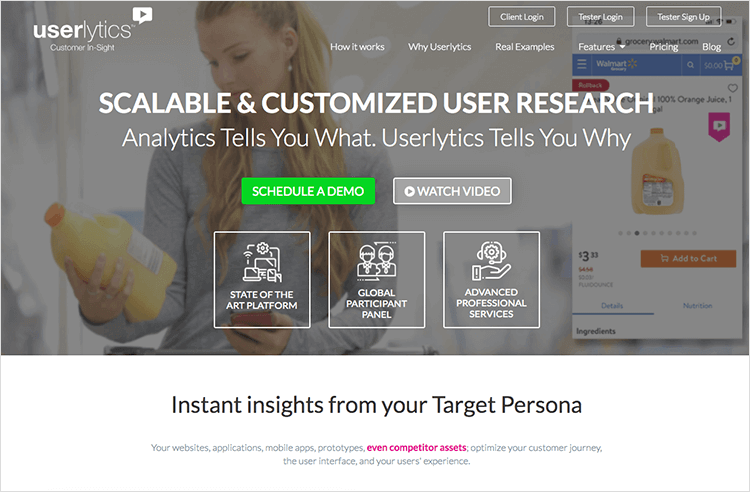
Among traits that did not get praise from users, is the way data is given to users after the results. The data visualization of the tool is rough and may represent a challenge to users who aren’t savvy when it comes to statistics. Other users express a wish to have more data displayed on the dashboard, while some claim the initial set up of studies can be time-consuming.
Among the main issues of the tool, is the fact that not all features are available to all plans, which can lead to some confusion over the pricing system.
- Who is it for: small and medium businesses
- Price: ranges from 49$/month to 69$/month
HotJar is among the usability testing tools that offer heatmaps as its key feature. The tool also enjoys a recording feature so users see the exact behavior of participants, as well as an option to easily create surveys, which has users listing praises on G2.
Going even further, one of the key aspects of the tool for many users was how easy it is to set up. Google Tag Manager has a HotJar tag just waiting for your ID – it takes only a moment to set everything up. Once you’re ready, it’s all about preparing the study and waiting for the magic to happen.
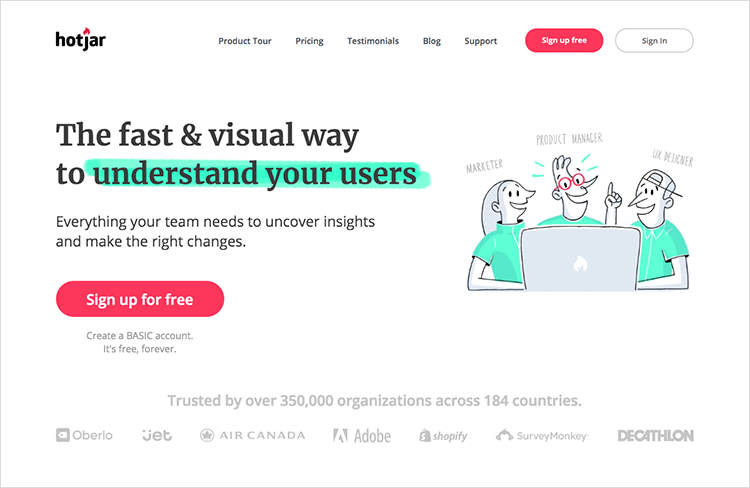
Among the positives of this user testing tool is their data visualization – which has earned massive points with users. It lays down the data in a way that makes it easy to draw insights, with all the right numbers at hand for users.
Another positive point is their educational content. Users receive emails that share important information about the tool and how to use it, while not overwhelming the user’s inbox. Users were also happy with the tool’s tutorials.
- Who is it for: small and medium businesses
- Price: Free plan available forever. Prices range from €29/month to €989/month.
Among the usability testing tools in the market, Optimizely is one of the well-known platforms many will recognize. It’s best known feature is its A/B testing, which earned it a spot on our list of top A/B testing tools – it’s other features, however, aren’t bad either!
One of the most attractive traits in this user testing tool is how easy it is to create new studies. There is no coding needed, as users can set everything up right on their dashboard. It is equipped to test modern websites, like pages that have dynamic content.
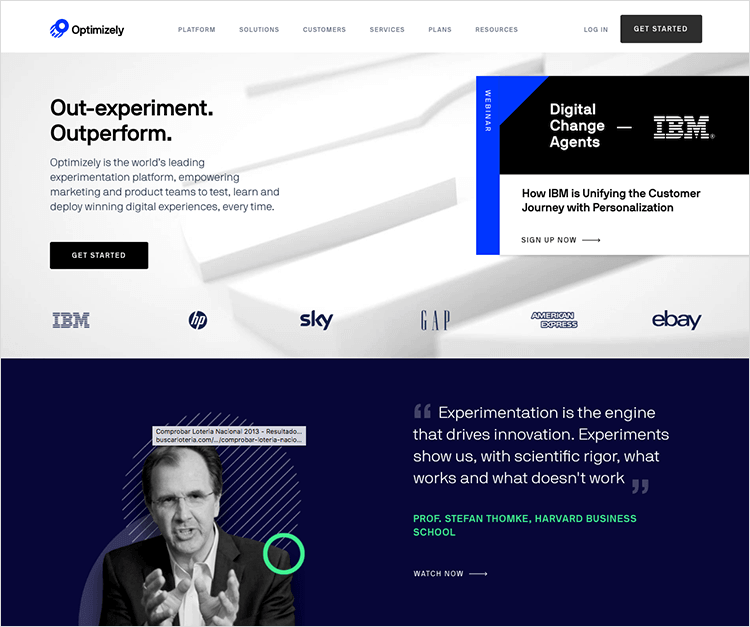
It also allows for some serious segmentation. It allows studies to be narrowed down to participants of certain geographical locations or that have a certain cookie setting, for example. This, of course, helps refine the study and awards more accurate results.
One of the best things about this user testing tool is that it was created for big teams that include more than just designers. Optimizely offers a visual editor for designers, several extensions, APIs and coding options for developers. It also offers a wide set of features aimed at managing the workflow of several teams within the tool itself, such as having an idea backlog, commenting, and even an idea scoring system.
- Who is it for: medium businesses and enterprises
- Price: available upon request
Lookback may not be one of the most known usability testing tools, but its features are more than enough to earn a spot on this list.
The tool enjoys some great functionalities, such as the option to timestamp and take notes at exact points in time of test recordings. Users were deeply fond of this feature, as it helped smooth communication regarding specific reactions from participants. The fact that all recordings are automatically saved on the cloud is also a great benefit of Lookback.

This user testing tool seems to enjoy many features that show promise when we consider the challenges faced by teams, especially teams that spread across more than one location. Their broadcasting feature means teams in different locations can watch the same test without any detail being lost to miscommunication, for example.
On the same note: Users can also make “secret” projects, which can have permissions and authority levels granted to other users.
Lookback is a rather flexible user testing tool, as it offers the options to carry out moderated or unmoderated tests – as well as in-person testing in your local lab. Another great thing about this too is that it works with Native Apps, which boosts their mobile-testing capabilities.
- Who is it for: small and medium businesses
- Price: from 49$/month to 99$/month. Enterprise plans available upon request.
TryMyUI is another interesting example among usability testing tools. It offers the options to test all sorts of wireframes or prototypes in remote studies. The tool works with websites and mobile products alike, and even includes some other options such as written surveys or impression testing.
As with some of the user testing tools on this list, this platform offers users the option to use their participant database or bring their own. Should users go with the TryMyUI database, they’ll enjoy some great screening and segmenting capabilities.
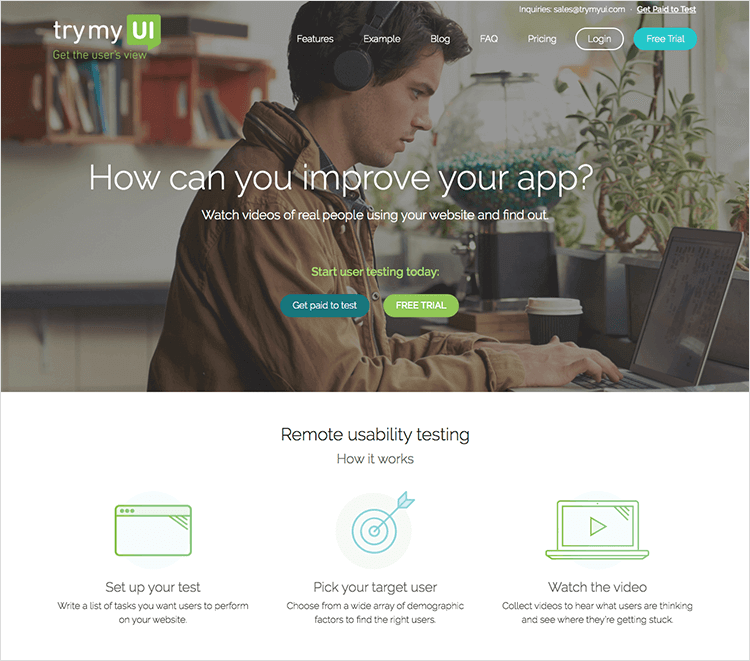
The key basic features, such as database screening, are available to all plans. Others, such as their UX Diagnostics feature, are available only to specific plans (in this case, the Teams and Enterprise plans). It is true that these additionals seem promising – the UX Sprint feature is all about getting workflows in order, and comparing previous with current test results once the design has been revisited.
- Who is it for: startups, small and medium businesses
- Price: monthly subscriptions of 299$ to 1.500$. Pay per result also available.
TestRail is an established name among usability testing tools. The Platform includes all the classic features of a user testing tool, such as having segmentation options for filtering data and offering data in real-time.
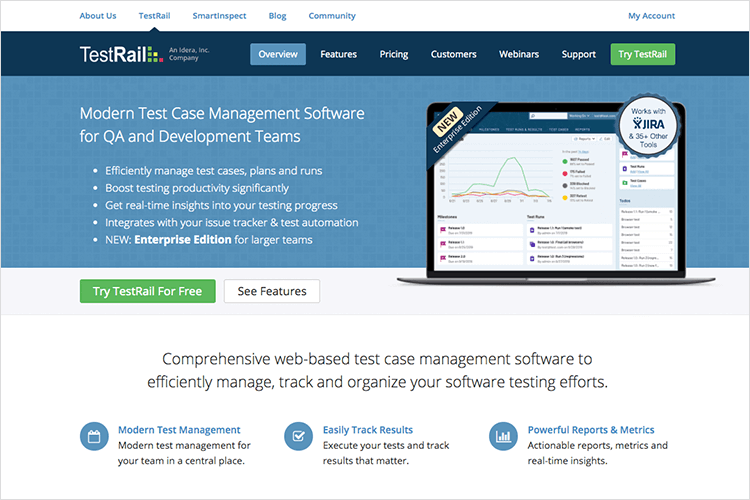
User reviews, especially those from enterprise employees, praise the tool’s ability to completely replace spreadsheets. TestRail manages to take all the data from the tests and studies and offer it to users who can take the data with them via the TestRail app. Inside the dashboard or the app, data analysis is made easy by smart filtering and even smarter display.
Another huge plus that comes with this user testing tool is the set of integrations it offers. Key tools that help design teams work such as JIRA, Vault, GitHub or Visual Studio Online all have their integrations ready to go. Users also have APIs ready for any other integration they may need.
- Who is it for: small and medium businesses, enterprises
- Price: from 32$/month to 334$/month. Enterprise plan available upon request.
Design, Prototype and Test the usability of your web and mobile apps with Justinmind. For Free. Unlimited projects!

Usabilia is slightly different from the other usability testing tools on this list. Unlike most, Usabilia has a very specific focus on what you can test with it: live products such as websites or apps, as well as email campaigns.
The tool isn’t necessarily built for testing prototypes or any design in its early stages. Rather, it aims to help designers and marketers to keep improving on the product even after it is released. This is awesome in its own right, as the way they help users get feedback from visitors in websites is both effective and creative.
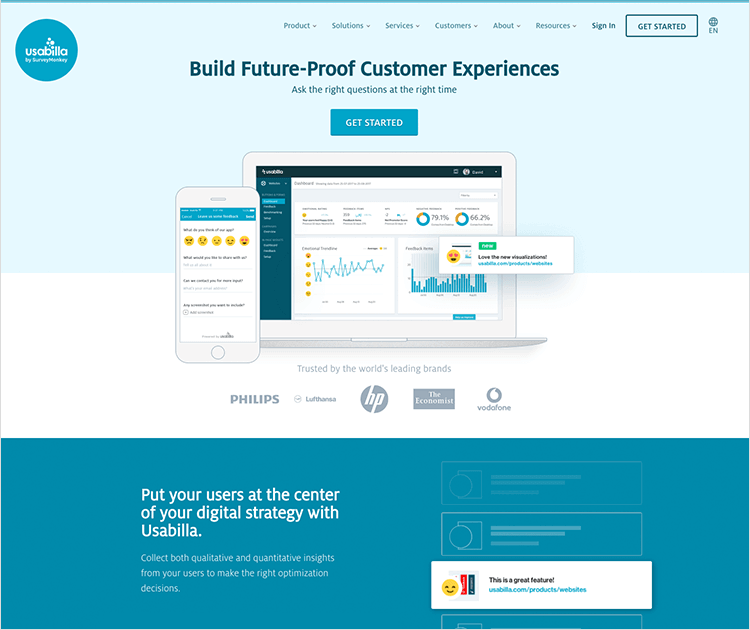
Users can create surveys, make and place a feedback button on their website, or create popups that can fit any website style and are easily customized. Every time a visitor leaves some feedback, users obtain both the feedback and a screenshot with a clear marking on what the visitor was referring to. No more guessing what people meant in your remote tests!
Their mobile app testing abilities aren’t bad either. Just by downloading and adding an SDK to the app, you can install their feedback button in mere moments. Users can control all efforts on all fronts from the dashboard.
- Who is it for: small and medium businesses, enterprises
- Price: available upon request
ClickTale is another special option within usability testing tools. ClickTale offers experience testing for both web and mobile – but here at Justinmind, we have a clear favorite: Mobile apps.
The platform records participants behavior in detail, and offers several different ways of processing that information. Users can see what participants did and how, by the recording and chronological break down of participants’ actions within the app. Users can also obtain heatmaps, for example.

An interesting differential that sets this apart from other usability testing tools is that users can set up different dashboards with their Experience Center. That means that product managers, developers and analysts can all have different KPIs on their dashboard so the team stays on focus.
The platform offers a Crash Trend report, that shows users exactly what causes these crashes. Not only that, but users can see each individual crash and review recordings of user’s actions leading up to that crash.
- Who is it for: Small and medium businesses, enterprises
- Price: available upon request
Optimal Workshop is among lesser known usability testing tools – but it shouldn’t be overlooked. The platform comes with a bundle of testing tools that serve different ends, and when combined can offer powerful insight into the design.
Their Treejack feature, for example, works to test information architecture within a product. You can test prototypes and wireframes with their Chalkmark feature, making easy to catch issues before they evolve into problems. Other usability testing tools include card sorting tests, online surveys and other qualitative research capabilities.

Optimal Workshop also offers the possibility of recruiting with their platform, with the full segmentation and filtering users have come to expect from testing tools. The platform also prides itself on having a quick pace, with studies being carried out by participants in as little as 4 hours.
Users in reviews have praised the platform UI for its practicality and intuitiveness. Users share online that the cost-for-value is nearly unmatched by other usability testing tools – making this platform a great option for those with a tight budget.
- Who is it for: startups, small and medium businesses
- Price: 99$/study, 166$/month and customizable plans
Usability testing is a non-negotiable in the UX design game. Today, people have come to have high expectations of all digital products, and so usability has never been more important. With this heavy weight aspect of product design, it’s only logical that teams would need the right usability testing tool.
While what makes a tool the right choice for your project may vary, it is true that good usability testing tools have some key boxes to check. Hopefully, with this list of awesome options, you’ll be able to find that one perfect fit.
Design, Prototype and Test the usability of your web and mobile apps with Justinmind. For Free. Unlimited projects!

